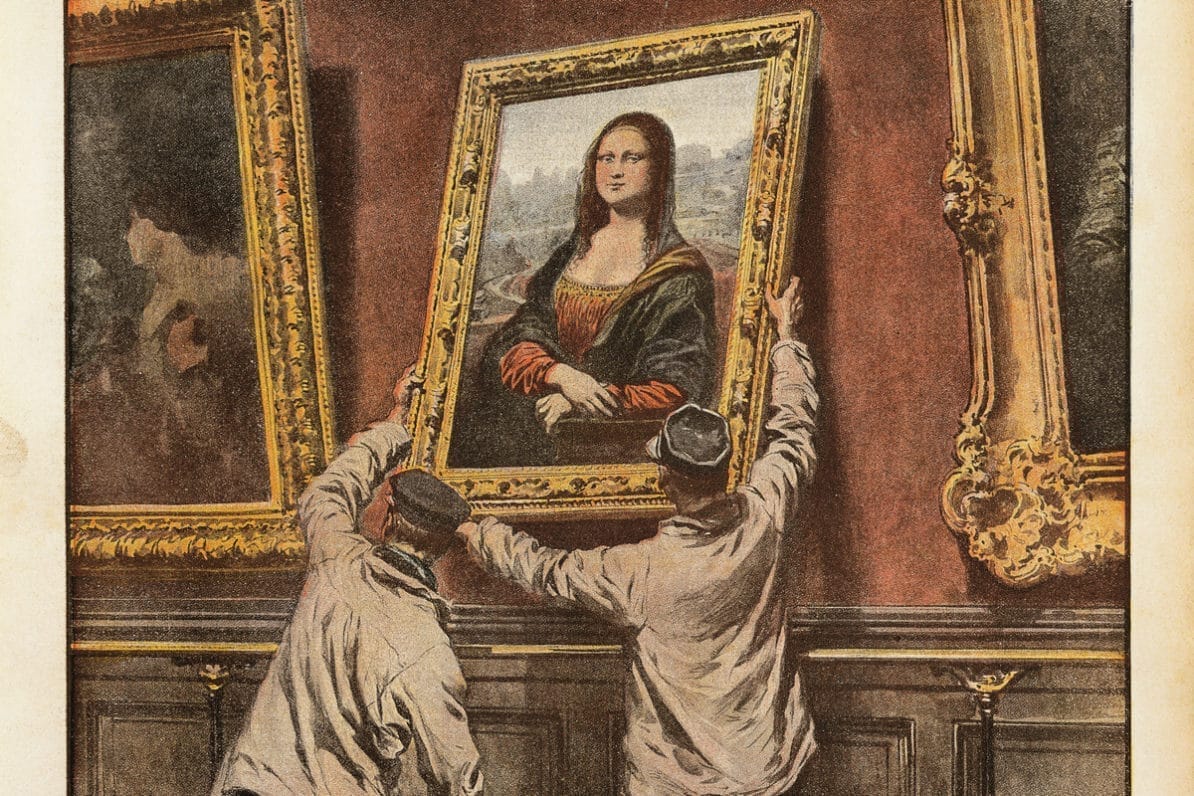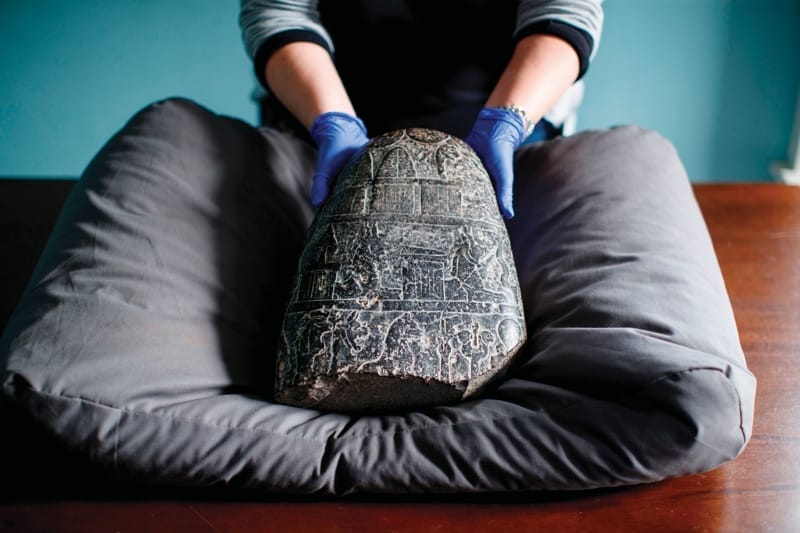The art of the steal – the grubby reality of masterpiece theft
From the theft of the Mona Lisa in 1911 to the “lost Michelangelo” stolen from a Belgian church in January 2019, art crimes have often captured the public’s imagination. But while such heists may conjure up images of the Thomas Crown Affair, the reality of looted masterpieces is far less romantic

An artist’s impression of the theft of the Mona Lisa, from La Domenica del Corriere magazine, published September 1911. Illustration: Achille Beltrame (1871-1945); photo: DeAgostini / Getty Images
11th January 2019 (Taken from: #34)
“There was an alarm in the church, but it was very old and kept going off and annoying the neighbours,” says Jan Van Raemdonck ruefully. “So we turned it off. We have a separate museum with a working alarm – maybe I should have put the painting in there?”
Van Raemdonck is a priest in the small Flemish town of Zele, 45 miles north of Brussels. When he first took up the position in 2018, he discovered a painting hidden away behind the high altar of his new church. Older than most of the pictures in the Baroque building and painted on board, the image of the baby Jesus asleep on Mary’s knee fascinated Van Raemdonck. An amateur historian, he began to look into the story behind The Silence of Our Lady.
Van Raemdonck’s investigations led him to the collection of the Duke of Portland in the UK, where he discovered a 1538 Michelangelo sketch which he believed to be “remarkably similar” to The Silence of Our Lady. If Michelangelo had used that sketch as the basis for the painting, then the church would be in possession of a masterpiece worth millions. It’s a big if. “There are only five known Michelangelo paintings on board,” concedes Van Raemdonck. “The idea that there was a sixth one here in Belgium seemed impossible. But I believed it was by him or one of his students.”

Jan Van Raemdonck in front of The Silence of Our Lady before the ‘lost Michelangelo’ was stolen. Photo: courtesy Jan Van Raemdonck
Despite his excitement, Van Raemdonck shared his discovery with only a handful of people, including respected Michelangelo expert Maria Forcellino. Days before Forcellino was due to appraise the piece the church, with its annoying and consequently deactivated alarm, was broken into and the painting stolen.
The Mystery of Zele is the latest in a long line of art heists stretching back through history. On 21st August 1911 Vincenzo Perruggia, an Italian decorator, emerged from the cupboard where he had been hiding all night, prised the Mona Lisa from her frame and walked out of The Louvre with her hidden under his coat. The blitz of publicity around the theft turned the portrait into a sensation. Queues formed outside the museum for the first time as people lined up just to see the empty space where the painting had once hung. By the time it was recovered two years later, the Mona Lisa was the most famous painting in the world.
While The Silence of Our Lady is unlikely to reach similar levels of fame, its theft did attract international headlines, with the Guardian declaring it a case “worthy of a Hercule Poirot whodunnit”. Speculation circulated about a sophisticated art thief stealing works to order, but Van Raemdonck has a more prosaic explanation. “I suppose it was somebody from the town,” he says with a sigh. “They probably stole it, sold it and spent the money on drugs.” Speculation has now died down and the investigation has gone quiet: Van Raemdonck says he hasn’t heard from the police working on the case in a month. “Let’s hope that whoever took it will repent their deeds and bring it back,” he says.
A bin full of crown jewels
While sceptical that The Silence of Our Lady is a lost Michelangelo, art expert Will Korner believes that it is perfectly possible it may reappear on the church’s doorstep. “Criminals often realise that publicity has made a stolen object too hot to handle,” he says citing the theft of the Swedish crown jewels from Strängnäs Cathedral in July 2018. “The press loved that story – it involved a speedboat chase and some literal daylight robbery,” says Korner. “But when the jewels were recovered in February 2019 it didn’t make the same splash.”
The criminals returned the jewels in a novel fashion, placing them in a dustbin, with the word ‘bomb!’ painted on the side. They placed the bin on top of a car before calling the authorities, who thankfully chose not to carry out a controlled explosion and blow Charles IX’s stolen funeral regalia to kingdom come.

Police tape surrounds Strängnäs Cathedral, Sweden, following the theft of royal jewels, July 2018. Photo: Pontus Stenberg / TT/TT News Agency / PA Images
“The thieves clearly came to the conclusion that they couldn’t really do anything with the jewels,” says Korner. “If it had been me, I would have broken them down – sold off a few diamonds at a time, melted down the precious metals… That’s what they should have done. You learn a lot when you’re on this side of the desk.”
Korner’s “side of the desk” is helping to run the Art Loss Register (ALR), the world’s largest private database of lost and stolen art, antiques and collectables. Set up by art and insurance professionals in 1990, the database now covers over half a million registered items. This vast index works as the art world’s due-diligence service – for a fee ALR will allow buyers and sellers to check any suspicions of illegitimate ownership before a work is sold, in order to avoid legal complications. It has a pretty good track record: since launch it has helped with the recovery of stolen items worth over £500 million.
These are usually lower-profile pieces than potential Michelangelos. “We tend to deal with the cases that don’t make the papers,” says Korner. “The objects aren’t that interesting to the media as they’re not that valuable – normally around the £10,000 mark – but they mean a hell of a lot to the people who originally owned them.” According to Korner, at any one time the team is checking on the legal status of 150 artworks. “Hopefully as our net gets bigger, as it has done every year, we’re not only disincentivising the actual theft, but lowering the value of what you would get if you stole an object.”
… drugs, human trafficking, weapons… It’s not this glamorous Hollywood-ised venture that a lot of people make it out to be”
As well as the best way to strip a Swedish crown for parts, Korner’s time at ALR has taught him that the reality of art crimes is a long way from the evocative headlines they can generate. “This isn’t The Thomas Crown Affair, with suave thieves pinching masterpieces in ingenious ways,” he says. “Most art crimes are opportunistic. The works are usually stolen by petty thieves during break-ins and then sold or passed along the criminal chain to larger criminal organisations that deal in drugs, human trafficking, weapons… It’s not this glamorous Hollywood-ised venture that a lot of people make it out to be.”
According to Korner, the vast majority of stolen artworks will be sold at flea markets or small auction houses for a fraction of what they are worth. If a painting is discovered to be particularly valuable then it is usually returned or ends up in the hands of organised criminal gangs who may put it aside for use as a future bargaining chip.
“There have been cases in Italy where mafiosi have been arrested and, in return for a reduced sentence, they have led law enforcement to stolen objects,” says Korner. “Whenever an old masterpiece that’s been missing for decades miraculously turns up under some grandmother’s bed or in an attic I’m suspicious that it’s the result of a deal like this.”
If you’re a sensible drug lord, then you should be investing in fine art”
A painting doesn’t even need to be stolen in order to help fund organised crime. “Artworks can sell for millions of dollars,” says Korner. “If you’re a sensible drug lord, then you should be investing in fine art. Buying a painting in one country and moving it to another to sell is a fantastic way of cleaning dirty cash. For some reason, when it comes to art, people do not ask the same questions that banks and property lawyers do. Let’s say you buy a Picasso for $10 million, and then you sell it for $8 million, I think most people involved in organised crime would be very happy to take that for laundered cash.”
Looting on an industrial scale
The majority of working hours at the Art Loss Register today are still spent dealing with pieces stolen during the Third Reich more than 70 years ago. We may have to wait a similar time to understand the consequences of modern-day perpetrators of industrial-scale looting.
“I think it will be years, maybe decades, before we discover the scale of theft from Iraq and Syria under Isis,” says Leila Amineddoleh. An art and cultural-heritage lawyer, Amineddoleh says the majority of items coming out of Isis-controlled territories in recent years are antiquities, which can be even harder to identify than looted art. “You can usually trace an artwork back to a prior owner,” she says. “Picasso did this work, it went to his dealer, it was sold to this person and so on. Looted antiquities are different. They’re from the ground. We often don’t know where they came from, even the country. People talk about Roman objects – that might not mean modern-day Italy. Roman objects are found as far north as Scotland. The sad reality is that the majority of looted objects will not be returned to their home country.”

A Babylonian boundary stone, looted from Iraq and seized at Heathrow airport in 2012, is handed back to Iraq in March 2019. Photo: TOLGA AKMEN / AFP / Getty Images
While Isis’s highly publicised attempted destruction of ancient sites such as Palmyra made for some useful propaganda for the ‘caliphate’, Amineddoleh believes that archaeological objects of value were more likely to be sold to fund the cause than to be destroyed. “We’ve found tunnels full of antiquities in former Isis territories,” she says. “If they were destroying antiques because they thought they were idolatrous, then why wouldn’t everything be destroyed? The thought is that they were hoping to get them on to the western market, because that’s where the value is.”
This value only exists because somebody is buying – usually a dealer who’s willing to play the long game. “At the moment everyone’s on high alert; people are naturally suspicious of objects coming out of Syria or Iraq,” says Amineddoleh. “Still, there are individuals spending hundreds of thousands, if not millions, of dollars, on these rare pieces. They will put them in warehouses and wait until there is the opportunity to sell them later down the line, when Isis has become just a memory.”
They are destroying these archaeological sites, destroying the heritage, destroying history”
Some collectors argue that by buying these looted objects, dealers and art lovers are saving pieces – getting them out of the hands of would-be destroyers and preserving them for future generations. Amineddoleh has little time for such rationales. “I believe purchasing loot incentivises looting,” she says. “If you’re buying these stolen antiquities, then looters know that there’s a market. These pieces are not being extracted by a trained archaeologist, they are being ripped out of the ground. They are destroying these archaeological sites, destroying the heritage, destroying history. I wish more people would recognise that and think past, ‘I want this object. I love it. I want it in my collection.’”
Back in Zele, pastor Jan Van Raemdonck is working on a book about the missing painting he loves.
With no insurance, he lives in hope that the work will be returned. “It is an object of devotion,” he says. “People came to pray before it. People felt close to the holy family when they were close to that painting. It deserves better than this.”
Slow Journalism in your inbox, plus infographics, offers and more: sign up for the free DG newsletter. Sign me up
Thanks for signing up.








